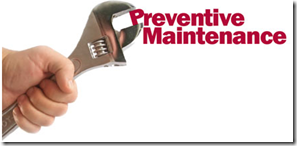 Preventive maintenance has been more popular in principle than in practice over the years. One can hardly argue with the idea of keeping equipment well maintained to extend its expected life and avoid future repair costs.
Preventive maintenance has been more popular in principle than in practice over the years. One can hardly argue with the idea of keeping equipment well maintained to extend its expected life and avoid future repair costs.
Less clear is an understanding of the actual relationship between the cost of preventive maintenance and the returns such activities can be expected to deliver. What is the process of assessing the value of preventive maintenance programs and activities by analyzing them in terms of key financial ratios?
Engineers and building operators trying to persuade property owners and managers to invest in preventive maintenance (PM) for their portfolios offer a range of solid arguments:
- “The equipment will perform better.”
- “Equipment life will be extended.”
- “Repair costs will fall.”
- “Downtime will be reduced.”
- “Tenant satisfaction will increase.”
- “The manufacturer says we need to do it.”
Although most owners acknowledge these issues, they may be more concerned with saving money and obtaining optimum value from their investments. Given that perspective, a more convincing argument for preventive maintenance would demonstrate that PM generates a solid rate of return in terms of risk mitigation and asset protection.
For example, how does one quantify the extended life of an air compressor? How can one know how much longer a compressor will last if it receives proper preventive maintenance than it would if no PM took place?
Sample Analysis
Here is a simple example. Suppose a company owns a 10-year-old, 7-horsepower air compressor. Replacing the compressor would cost $32,900. Is an investment in preventive maintenance justified? Based on the standard procedures, the compressor will last 20 years with proper PM but only 16 years without it.
Proper PM will cost $472 per year. Repairing the compressor will cost $944 per incident. If maintained properly, it will need to be repaired once every four years. If it is not maintained, the compressor will need to be repaired every three years. Given these variables, and assuming a time frame of 25 years, is an investment in preventive maintenance justified?
With preventive maintenance, the equipment will need to be repaired once every four years at a cost of $944, a figure that translates to $236 per year. Lacking preventive maintenance, the compressor can be anticipated to need repairs once every three years for the same $944 cost, which equals $315 per year. With preventive maintenance, the compressor will need to be replaced in year 10. Without PM, it will have to be replaced twice, in year 6 and year 20. Comparing the two scenarios indicates that the PM scenario has a net present value (NPV) of $6,359.
If the time period is extended to 30 years, the compressor will need to be replaced twice in the PM scenario. This reduces the NPV to $4,338.
In either case, the investment in PM is clearly justified economically.
For purposes of simplicity, this example does not consider inflation, residual value, energy or lost revenue from downtime. If residual value (how much the compressor is worth after year 25) is factored in, for example, the NPV would decrease. But each of the other factors would cause an increase in NPV that would more than compensate for the effect of the residual. Think in terms of the entire array of equipment within a given 100,000 square foot building and consider the aggregate cost savings of implementing a comprehensive Preventative Maintenance Program.
For more information please contact sjohnson@paragonservice.us.com

